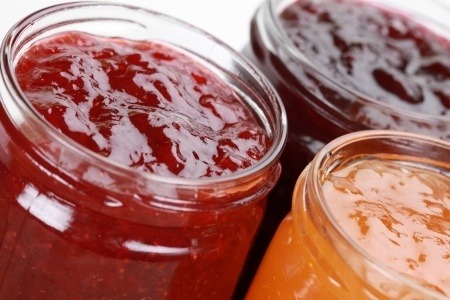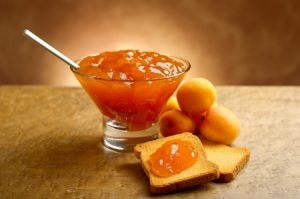
Pectins are complex plant heteropolysaccharides in the plant cell wall which are vital in cell structure and functioning. They are found in all the higher plants and occur amongst other componentry in the intercellular or middle lamellar region between cells, and provide channels for the passage of nutrients and water. In cell walls, pectic substances serve as one of the main agents cementing the cellulose fibrils together and they may be linked covalently to other carbohydrates and even proteins. Pectins influence growth, development and senescence, and affect the textural properties of plant tissues and fruits, especially their sturdiness (Inari et al., 2002).
Pectin makes up between 15 and 45 percent of the dry weight of fruits (Selvendran, 1983).
Pectic substances are classified as protopectins, whereas commercially, the pectins are divided into either high-methoxyl (HM) pectins or low-methoxyl pectins. The high-methoxyl types are usually industrially defined as either rapid set or slow set pectins depending on their degree of methoxylation (DM) and where the soluble solids or sugar content needs to be above 66% w/w with an acidic pH below 4, for any gelling to occur. The other commercial types are low-methoxyl (LM) pectins which need a 33%w/w solids content and calcium cross-linking to encourage setting and are often found in low sugar jams and the pectic acids.
Chemical Structures Of Pectin
Pectin is a complex heteropolysaccharide with homogalacturonan, rhamnogalacturonan I and rhamnogalacturonan II as the predominant structures (Willats et al., 2001). A number of interesting neutral sugar glycans are also involved (Ovodov, 2009).
Homogalacturonan is composed of (1-4)-linked α-D-galacturonic acid residues. It is the basic pectin structure. Some carboxyl groups are esterified to methyl groups whilst various hydroxyl groups are partially acetylated at the O-2 and/or O-3 groups. There is also some amidation of these carboxyl groups, introduced chemically to alter the gel behaviour. All these groups modify the gelling behaviours of pectins and so have a profound effect on their functional properties.
There are a number of variants:-
Rhamnogalacturonan I is made up of (1-4)-linked α -D-galacturonic acid and (1-2)-linked α -L-rhamnose, which are alternatively combined with each other in the backbone. Some of the rhamnose residues contain side chains, such as arabinan, galactan and arabinogalactan at the 4-O-rhamnose (Vincken et al., 2003).
Rhamnogalacturonan II is considered a highly complex structure. It is composed of a (1-4)-linked α -D-galacturonic acid residue backbone and unique sugars such as D-apiose, 2-keto-3-deoxy-D-manno-2-octulosonic acid (Kdo), 3- deoxy-D-lyxo-2-heptulosaric acid (Dha), aceric acid and others, which are present in side chains attached at O-2 or O-3 of some of the galacturonic acid residues in the backbone (Ridley et al., 2001; Willats et al., 2006).
Degree Of Methoxylation (DM)
Pectins are HM or LM depending on the extent of methoxylation of the galacturonic acid (GalA) residues. A methoxylation level greater than 50% puts a pectin into the HM category.

Pectin Extraction
Good sources of pectin are extracted from apple pomace, citrus peel especially orange and lemon, and sugar beet pulp (Kar & Arslan, 1999). Each source offers a slightly different setting capability and is exploited by product developers looking for slight variations.
Pectin is commercially extracted from apple and citrus sources using strong acid or alkali. Some of the other potential commercial sources include waste fruit and vegetable peels such as carrot pomace (Jafar et al., 2017).
The quality of the pectin varies in each case.
Apple pomace contains 1.2% w/w pectin (Virk & Sogi, 2007).
Fruits are divided into four groups based on their pectin and acid contents:
(1) Rich in pectin and acid: sour and crab apple, sour plum, jamun, sour orange, lemon, grape, sour guava.
(2) Rich in pectin but low in acid: low acid apples, unripe banana, sour cherry, unripe fig, pear, orange and its peel, grapefruit, ripe guava.
(3) Low in pectin but rich in acid: sour apricot, sweet cherry, sour peach, strawberry and pineapple.
(4) Low in pectin and acid; apricot, ripe peach, raspberry, mainly over-ripe fruit..
Pectin Applications
Pectins are widely used in the food industry because of their gel-forming properties and were recognised for this when different fruit types were used. They are generally used as gelling agents and stabilisers in jams, jellies and acid milk products. Raspberry jam relies on its set for pectins released during the boiling process. Strawberry jam on the other hand does not contain enough pectin in its cell structure and so must rely on added pectin to generate the set.
Pectins can be blended with other materials such as starch. When they are blended with this material and plasticized with glycerol, they form edible and biodegradeable films that have a range of mechanical properties. Plenty of research papers have been written over the years on pectin films from the Eastern Regional research center of the USDA in Wyndmoor, Pennsylvania USA (Coffin & Fishman, 1993; Fishman & Coffin, 1995; Fishman et al., 1996, 1999).
Nutritional Benefits
Pectins have several biological and physiological functions:-
- reduction of serum cholesterol (Brown et al., 1999),
- stimulation of phagocytes and macrophages (Iacomini et al., 2005; Popov et al., 1999),
- spleen cells proliferation (Wang et al., 2005; Zhao et al., 2006),
- anticomplementary activity (Samuelsen et al., 1995; Yamada, 1994)
- inhibition of hyaluronidase and histamine release (Sawabe et al., 1992).
It is also reported that citrus pectin and its modified derivatives have inhibitory effects on fibroblast growth factor signal transduction (Liu et al., 2001; 2002), suppression of LPS-induced inflammatory responses (Chen et al., 2006) and preventive effect on cancer growth and metastasis (Platt and Raz, 1992; Nangia-Makker et al., 2002a & b).
Pectins In Gut Health
Pectins are resistant to digestion in the gut which is why they are very useful as soluble dietary fibre. They are however broken down by enzymes produced by bacteria in the gut and so these carbohydrates make good prebiotic ingredients along with insulin. The enzymes produced are bacterial beta-glucosidases and the substrates are galacturonic acid molecules which are then fermented by the bacteria. In our favour, the bacteria then produce short-chain fatty acids (SCFA), carbon dioxide, water and methane (Cummings et al., 1979). All these products are metabolized further by the bacteria, or excreted, or absorbed in the mucosa of the colon (Pomare et al., 1985).
It is reckoned that about 55% of the energy content of pectin becomes available to its host having eaten it through colonic absorption of SCFAs alone. It is well known that SCFAs entering the portal blood circulation are removed by the liver to serve as an important carbon source (Demigne and Remesy, 1985; Soergel, 1982). That just shows how useful pectin is in the diet.
Pectins And Lipid Metabolism
Pectins have a profoundly beneficial impact on lipid metabolism. It has been known for many years that pectin lowers serum cholesterol levels (Miettinen & Tarpila, 1977; Demigné et al., 1986; Brown et al., 1999). The mechanisms by which it does so are many fold. It includes reducing cholesterol absorption (Kiriyama et al., 1969), binding bile salts and increasing faecal sterol losses.
References
Brown, L., Rosner, B., Willett, W. W., & Sacks, F. M. (1999). Cholesterol lowering effects of dietary fiber: A meta-analysis. Am. J. Clin. Nutr., 69, pp. 30–42.
Chen, C.-H., Sheu, M.-T., Chen, T.-F., Wang, Y.-C., Hou, W.-C., Liu, D.-Z., et al. (2006). Suppression of endotoxin-induced proinflammatory responses by citrus pectin through blocking LPS signalling pathways. Biochemical Pharmacology, 72, pp. 1001–1009
Coffin, D. R., & Fishman, M. L. (1993) Viscoelastic properties of pectin/starch blends. Journal of Agricultural and Food Chemistry, 41(8), pp. 1192-1197 (Article)
Coffin, D. R., & Fishman, M. L. (1994). Physical and mechanical properties of highly plasticized pectin/starch films. Journal of Applied Polymer Science, 54(9), pp. 1311-1320.
Coffin, D. R., Fishman, M. L., & Ly, T. V. (1996). Thermomechanical properties of blends of pectin and poly (vinyl alcohol). Journal of applied polymer Science, 61(1), pp. 71-79 (Article).
Cummings, J. H., Southgate, D. A. T., Branch, W. J., Wiggins, H. S., Houston, H., Jenkins, D. J. A., … & Hill, M. J. (1979). The digestion of pectin in the human gut and its effect on calcium absorption and large bowel function. British Journal of Nutrition, 41(3), pp. 477-485.
Demigné, C., & Rémésy, C. (1985). Stimulation of absorption of volatile fatty acids and minerals in the cecum of rats adapted to a very high fiber diet. The Journal of Nutrition, 115(1), pp. 53-60
Demigné, C., Yacoub, C., & Rémésy, C. (1986). Effects of absorption of large amounts of volatile fatty acids on rat liver metabolism. The Journal of Nutrition, 116(1), pp. 77-86.
Fishman, M. L., Coffin, D. R., Konstance, R. P., & Onwulata, C. I. (2000). Extrusion of pectin/starch blends plasticized with glycerol. Carbohydrate Polymers, 41(4), pp. 317-325 (Article).
Iacomini, M., Serrato, R. V., Sassaki, G. L., Lopes, L., Buchi, D. F., & Gorin, P. A. J. (2005). Isolation and partial characterization of a pectic polysaccharide from the fruit pulp of Spondias cytherea and its effect on peritoneal macrophage activation. Fitoterapia, 76, pp. 676–683.
Inari, T., Yamauchi, R., Kato, K., & Takeuchi, T. (2002). Changes in pectic polysaccharides during the ripening of cherry tomato fruits. Food Sci. Technol. Res., 8, pp. 55–58.
, , , & (2017). Pectin from carrot pomace: Optimization of extraction and physicochemical properties. Carbohydrate Polymers, 157, pp. 1315–1322 (Article)
Kar, F., & Arslan, N. (1999). Characterization of orange peel pectin and effect of sugars, L-ascorbic acid, ammonium persulfate, salts on viscosity of orange peel pectin solutions. Carbohydrate Polymers, 40, pp. 285–291.
Kiriyama, S., Okazaki, Y., & Yoshida, A. (1969). Hypocholesterolemic effect of polysaccharides and polysaccharide-rich foodstuffs in cholesterol-fed rats. The Journal of Nutrition, 97(3), pp.382-388.
Liu, Y., Ahmad, H., Luo, Y., Gardiner, D. T., Gunasekera, R. S., McKeehan, W. L., et al. (2001). Citrus pectin: characterization and inhibitory effect on fibroblast growth factor-receptor interaction. J. Agric. Food Chem., 49, pp. 3051–3057.
Liu, Y., Ahmad, H., Luo, Y., Gardiner, D. T., Gunasekera, R. S., McKeehan, W. L., et al. (2002). Influence of harvest time on citrus pectin and its in vitro inhibition of fibroblast growth factor signal transduction. J. Sci. Food Agric., 82, pp. 469–477.
Miettinen, T. A., & Tarpila, S. (1977). Effect of pectin on serum cholesterol, fecal bile acids and biliary lipids in normolipidemic and hyperlipidemic individuals. Clinica Chimica Acta, 79(2), pp. 471-477.
Nangia-Makker, P., Conklin, J., Hogan, V., & Raz, A. (2002). Carbohydrate-binding proteins in cancer, and their ligands as therapeutic agents. Trends in Molecular Medicine, 8, pp. 187–192.
Nangia-Makker, P., Hogan, V., Honjo, Y., Baccarini, S., Tait, L., Bresalier, R., et al. (2002). Inhibition of human cancer cell growth and metastasis in nude mice by oral intake of modified citrus pectin. J. National Cancer Inst., 94, pp. 1854–1862.
Ovodov, Y.S. (2009) Current views on pectin substances. Rus. J. Bioorg. Chem. 35 pp. 269–84.
Platt, D., & Raz, A. (1992). Modulation of the lung colonization of B16-F-1 melanoma cells by citrus pectin. J. National Cancer Inst., 84, pp. 438–442
Pomare, E. W., Branch, W. J., & Cummings, J. H. (1985). Carbohydrate fermentation in the human colon and its relation to acetate concentrations in venous blood. The Journal of Clinical Investigation, 75(5), pp. 1448-1454.
Popov, S. V., Popova, G. Yu., Ovodova, R. G., Bushneva, O. A., & Ovodov, Y. S. (1999). Effects of polysaccharides from Silene vulgaris on phagocytes. Int. J. Immunopharmacology, 21, pp. 617–624.
Ridley, B. L., O’Neill, M. A., & Mohnen, D. (2001). Pectins: Structure, biosynthesis, and oligogalacturonide-related signaling. Phytochemistry, 57, pp. 929–976.
Samuelsen, A. B., Paulsen, B. S., Wold, J. K., Otsuka, H., Yamada, H., & Espevik, T. (1995). Isolation and partial characterization of biologically active polysaccharides from Plantago major L. Phytotherapy Research, 9, pp. 211–218.
Sawabe, Y., Nakagomi, K., Iwagami, S., Suzuki, S., & Nakazawa, H. (1992). Inhibitory effects of pectic substances on activated hyaluronidase and histamine release from mast cells. Biochimica et Biophysica Acta, 1137, pp. 274–278
Selvendran, R. R. (1983) The chemistry of plant cell walls. In: Dietary Fibre, (Birch, G. G. & Parker, K. J., eds.), pp. 95-148, Applied Science Publishers, London.
Soergel, K. H. (1982) Absorption of fermentation products from the colon. In: Colon and Nutrition (Kasper, H. & Goebell. H. eds.) pp. 27-35, MTP Press Limited, Lancaster.
Vincken, J. P., Schols, H. A., Oomen, R., Beldman, G., Visser, R., & Voragen, A. G. J. (2003). Pectin – The hairy thing: Evidence that homogalacturonan is a side chain of rhamnogalacturonan I. In F. Voragen, H. Schols, & R. Visser (Eds.), Advances in pectin and pectinase research. Dordrecht: Kluwer Academic Publishers. pp. 91–105
Wang, X. S., Liu, L., & Fang, J. N. (2005). Immunological activities and structure of pectin from Centella asiatica. Carbohydrate Polymers, 60, pp. 95–101.
Willats, W. G. T., Knox, J. P., & Mikkelsen, J. D. (2006). Pectin: New insights into an old polymer are starting to gel. Trends in Food Science & Technology, 17, pp. 97–104.
Willats, W. G. T., McCartney, L., Mackie, W., & Knox, J. P. (2001). Pectin: Cell biology and prospects for functional analysis. Plant Molecular Biology, 47, pp. 9–27.
Yamada, H. (1994). Pectic polysaccharides from Chinese herbs: Structure and biological activity. Carbohydrate Polymers, 25, pp. 269–276.
Zhao, Z., Li, J., Wu, X., Dai, H., Gao, X., Liu, M., et al. (2006). Structures and immunological activities of two pectic polysaccharides from the fruits of Ziziphus jujuba Mill. cv. jinsixiaozao Hort. Food Res. Int., 39, pp. 917–923

Jam making sounds so delicious! I love the way we hold onto the fruit season — there is much about spring and summer I want to hold onto. I really find it is my kitchen trials with the pectin set that can be incredibly rewarding. I also learn from my mistakes and it is through them that I have achieved so much more – all the different fruit and flavour combinations with preserves and then knowing how much pectin to add or just leave as is. I like other blog recipes but your style is a bit different to others as so few talk about why jam setting is difficult to achieve. I’m sure you’ve noticed when I’ve added the odd comment.
Some day I will delve into the world of preserving other fruits from my market in Beaverton, which has interested me for a long time. I started looking more at pectin setting and how to use fruit acid like citric acid which you’ve mentioned elsewhere to get the right level. You’ll be first on my list of inspirations!